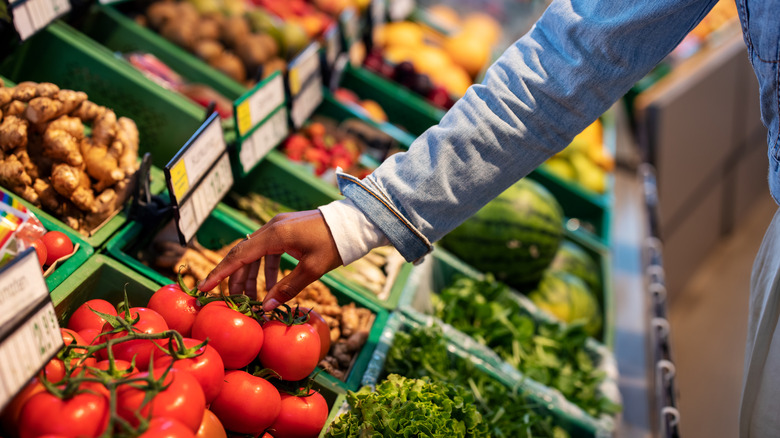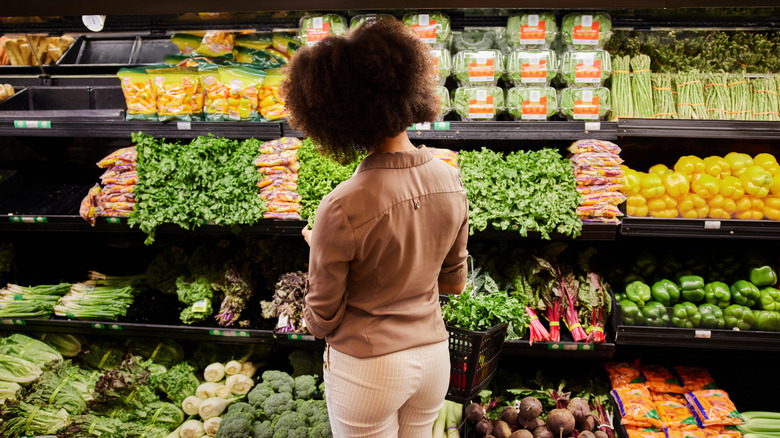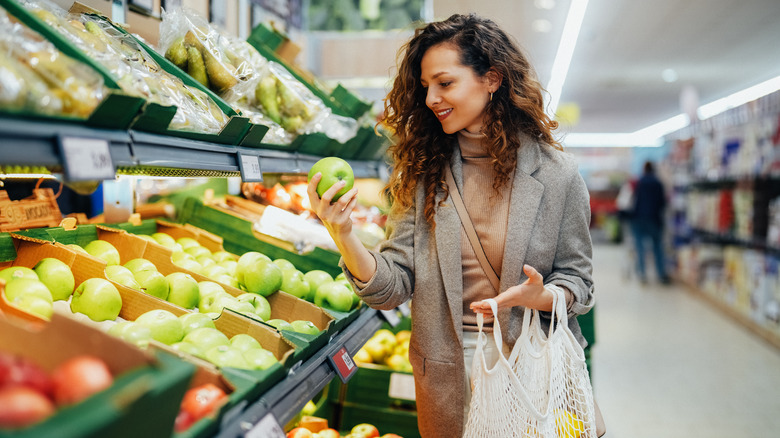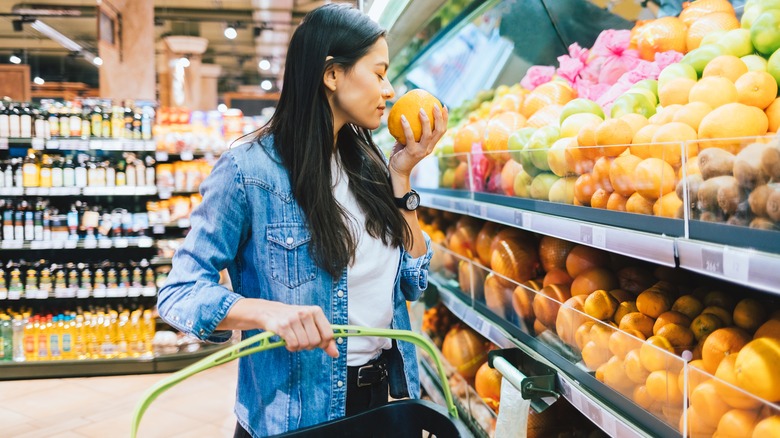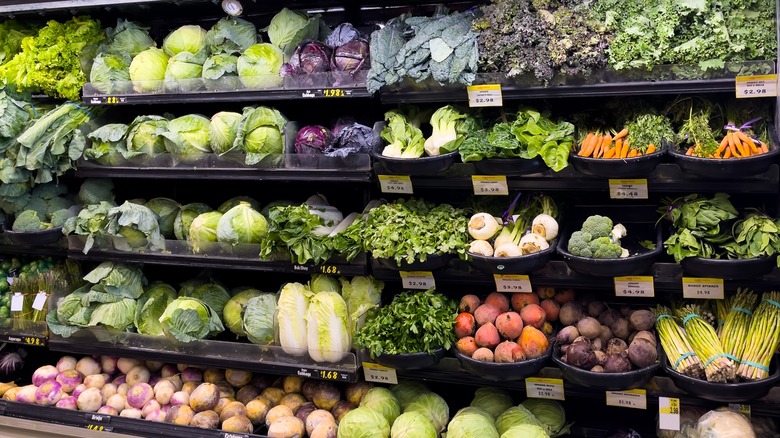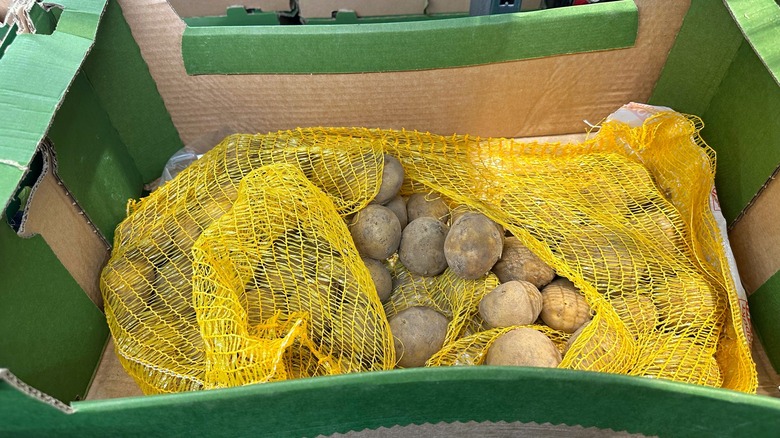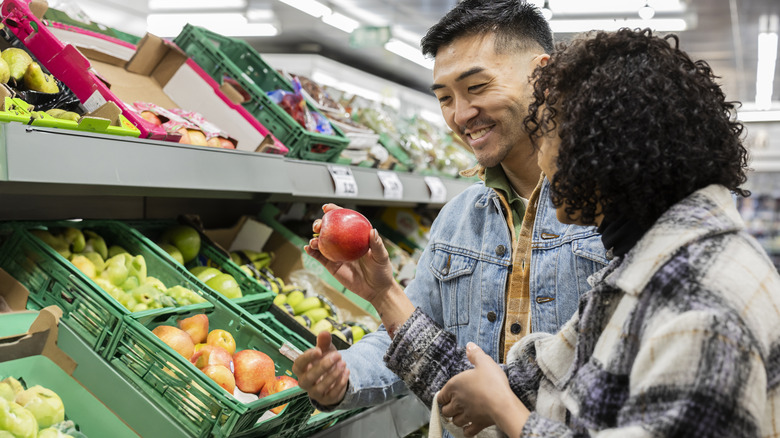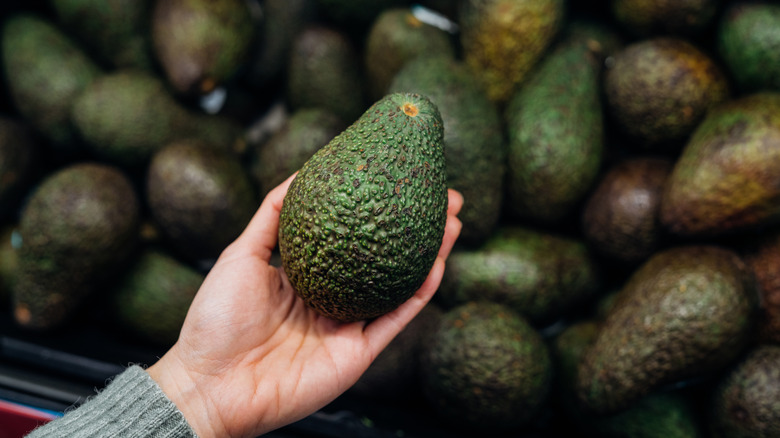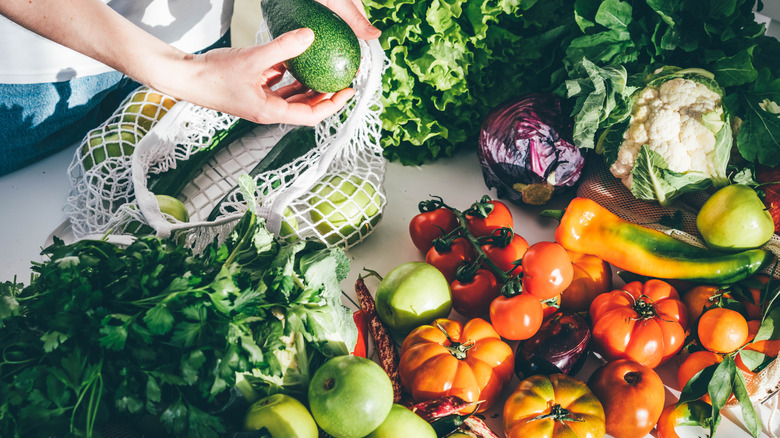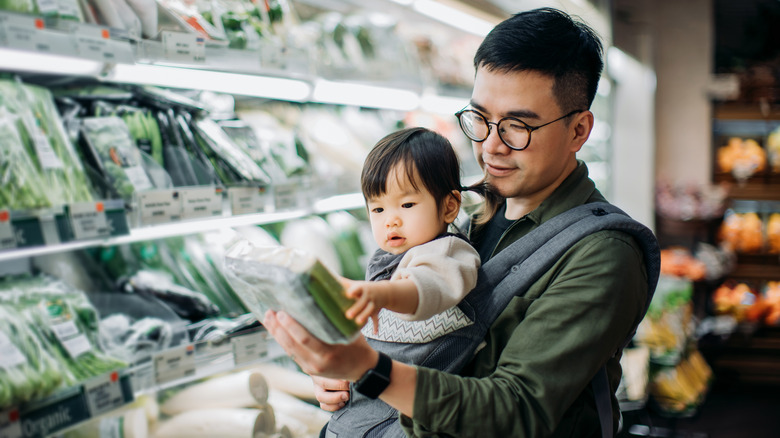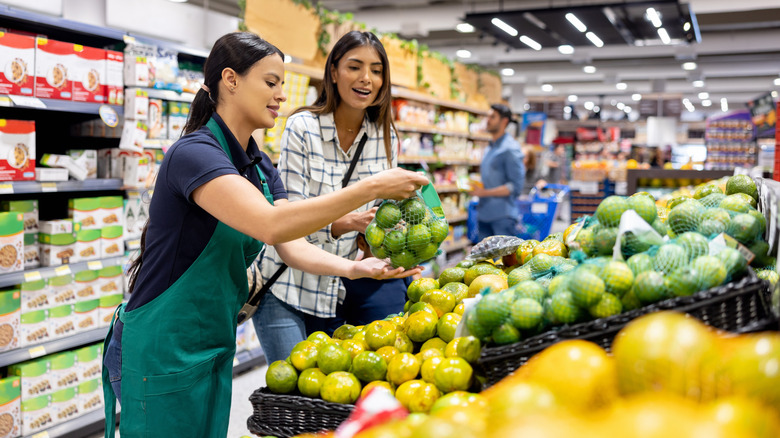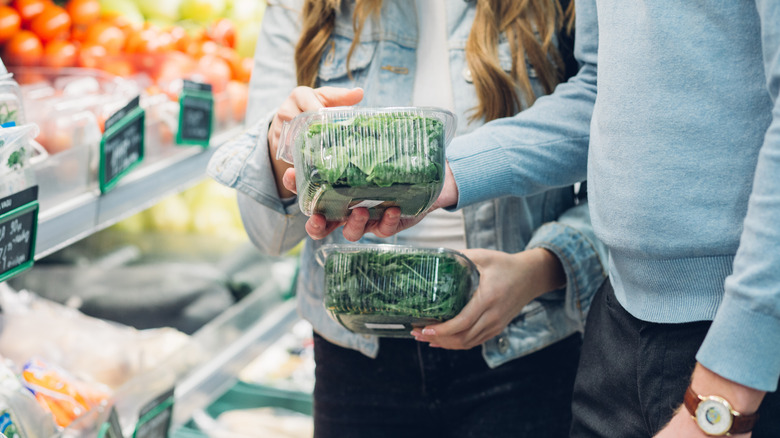Tricks And Tips Food Experts Use For Finding The Freshest Grocery Store Produce
You surely want your fruits and vegetables to be perfectly ripe, but finding fresh produce at grocery stores can be a challenge. Are you sick of mushy herbs, limp carrots, and bruised peaches? Do you want to stop feeling like finding avocado that's neither hard nor brown and stringy is like stumbling across the holy grail? You're not alone. Many of us think that there's got to be a better way to find great produce at your local store.
We wanted to know the secrets to finding perfect grocery store produce, so we spoke to two experts on the matter. First, we interviewed Milena Pagan, chef and owner of Puerto Rican café Little Sister and Rebelle, a bakery specializing in bagels. As a chef and business owner, it's important for Pagan to find high-quality produce, so she knows how to pick the best. Then we talked with Josiah Leet, Produce and Floral Field Inspector at Whole Foods Market whose entire job revolves around making sure produce is up to scratch.
Armed with their knowledge, we put together this list of tricks and tips food experts use for finding the freshest grocery store produce. Not only will these tips help you find better quality fruits and veggies, they could mean you end up wasting less food and ultimately save you time and money because you aren't having to replace produce that went bad. So, here's to tastier, fresher produce and fewer trips to the grocery store.
Look at produce
It seems simple, but you have to start by using your senses. Take a look at the produce. Now, this isn't foolproof, but it certainly is the first step to checking whether or not produce is fresh. It's easy to just grab the first package you come across when you're in a hurry, but it's worth spending the time to check for freshness, starting with your eyes.
"Usually the fruit or vegetable has a way of telling you how fresh it actually is," says Whole Foods produce inspector Josiah Leet. "Look for a bright surface color, firm feel and solid texture and absence of dried or sunken areas." A quick glance can sometimes be all you need to see that it's not worth putting something into your basket.
Chef and bakery owner Milena Pagan agrees that you can often tell when produce is fresh just by looking at it. "If it looks good it's probably going to taste good," she remarks. She also gives us some more specific factors to watch out for. "If you have greens or herbs you want them to look crisp and not wilty," she notes. Pagan adds that herbs shouldn't look wet, which means they're losing their freshness. The same goes for mushrooms — if they show moisture then they're past their prime. "Bright colors in fruits and vegetables are also a good tell," Pagan informs us. "Bruised produce is another sign it's not fresh — if it's squishy or bruised, then it's not fresh."
Feel produce
Where possible, you should also get your hands on produce to see if it's fresh. However, you should do this carefully, as you don't want to bruise every plum by roughly squeezing it. It's also polite not to spend too much time feeling every bit of produce at the grocery store when people are waiting behind you. Just feel it out — literally.
Every item of produce is different, so there's not just one thing you're looking for when trying to decide if something is fresh. For instance, some fruits should be soft and yielding, while others are better if they are firm and crisp. Our experts gave us some examples of what to look out for with particular types of produce, but if you're not sure what to look for, you might have to do some research before heading to the store.
"Avocados will have a slight give with moderate firmness," Whole Foods produce expert Josiah Leet tells us. "The stem should still be attached and there should be no divots or sunken spots." He adds that "pineapples will be firm but with a subtle color change from green to gold across the hexagonal surface (called 'fruitlets')." Apples, he explains, should have a good weight in the hand and a firm texture. Meanwhile, "garlic heads need to feel firm," says chef Milena Pagan. "If they're too old the cloves shrivel up in the peel, so when you touch it, it'll feel like a paper ball you can squish."
Smell produce
Smelling certain types of produce can tell you if it's perfectly ripe. However, this is only true of some fruits and veggies. "Things like pineapples, mangos and tomatoes you should be able to hold up to your nose and smell the fruit, that means it's at its peak," Milena Pagan remarks.
You might also be able to smell when certain foods are past their prime with a careful sniff. "It may not be outright decay, but [intense or overly sweet] fragrance is typically an indicator for overripe fruit and vegetables," says Josiah Leet. So, you should always use your nose when buying produce. Will you feel silly sniffing every tomato in the produce aisle? Maybe. But will it help you find the best fruits and veggies? Most probably.
You might notice a sickly sweet scent from some fruits, which tells you that they're more ripe than they should be. And, of course, some produce smells outright awful when it has spoiled. For instance, when broccoli starts to reek, that clearly means it's gone off. It should have a fresh smell reminiscent of vegetation, but if you get any more pungent whiffs than that, it has probably gone off and is best left to the compost pile. However, there are some fruits that are naturally stinky. For instance, many claim that a durian fruit smells pretty bad, but that's more likely to be its natural odor coming into conflict with shoppers who are unused to the fruit's nature.
Opt for loose fruits and veggies
Some produce is sold in packaging, whether that's in a box, wrapped in plastic, or in a bag. Other fruits and veggies are sold loose, depending on the type of store you're at and what you're buying. For instance, you won't often find loose berries at a grocery store as they're likely to get damaged by shoppers, but you'll often find more robust produce sold loose, such as potatoes and apples.
So is it better to buy loose or packaged produce? For the most part, loose is the way to go. Chef Milena Pagan says that this is because you can choose which individual items to buy, focusing on quality, rather than being stuck with whatever's in the package. "I never buy the produce that's wrapped up," she says. "It's better to hand pick."
Some people think that food wrapped in plastic may last longer, but that's actually not the case except in the case of pre-cut items. Not only does it create arguably unnecessary plastic waste, but this practice might also lead to more food waste as well when lower-quality parts are discarded. That said, not everyone is wholly against plastic-wrapped produce. "Overall, as long as the produce items have been picked and packed properly, and correctly handled through the supply chain, it shouldn't matter if they are wrapped or loose," Josiah Leet of Whole Foods Market says.
Look for unwashed produce
You might shy away from those potatoes or carrots that are sold loose with the dirt still on, but the general rule is that these will stay fresher for longer when compared to washed produce. That's because, when you wash fruits and vegetables, it creates an environment where bacteria can grow and spoil produce more quickly.
Plus, you'll need to wash your produce before eating it either way, so what's a little extra scrubbing? "Most produce should be washed post-purchase and right before you use it," Josiah Leet tells us. However, "some produce, like lettuces, radishes, leeks, etc., has to be prepped in the store before displaying, which includes vigorous washing," he adds. In other words, it's not always possible to buy fruit and veggies that are entirely unwashed.
Of course, there are exceptions. In some cases, you might be willing to pay extra for the convenience of washed produce, even if it comes with a shorter shelf life. "Salad greens and herbs are the ones I'm willing to pay more for the convenience because if not, it takes so much manhandling to wash them you can bruise them in the process," says Milena Pagan. She adds that it's way more convenient because you ought not to use leaves when they're still wet post-wash, as this can make a salad or other dish overly damp.
Consider which grocery store to shop at
If you're often disappointed at how quickly the produce you buy starts to go bad, then perhaps grocery store you shop at could be the culprit. You'd think that fruits and vegetables were of a similar freshness at all major grocery stores in the U.S., but it's not necessarily the case. Aldi has garnered something of a bad reputation for its produce, for example, which reportedly tends to spoil before shoppers expect. However, that reportedly varies from store to store, so it might not be a problem across the whole chain but just with your local branch.
So, what to do? Seek out specialists. "If there's a produce specialty store nearby, I always go there first, but for all purposes I go to Market Basket," Milena Pagan tells us. "I like it because it's a high volume/product turnover so you know the produce isn't just sitting there. Whole Foods also takes a lot of care with sorting their produce."
You might find the best produce at small, specialty produce stores or farmer's markets. But when you just want to go to an average grocery store or supermarket, it pays to know which ones in your area have particularly fresh produce. It might take some shopping around to figure out, or perhaps a look at some local reviews. You might start with stores known for especially fresh fruits and veggies, such as Trader Joe's or Sprouts Farmers Market.
Check the produce is ripe but not overripe
The tough thing about buying produce is finding that sweet spot on the scale of ripeness. You want a fruit or veggie to be ripe enough that it's going to taste its best and have a good texture. However, you obviously don't want it to be overripe or so close to overripe that it'll start to spoil within a few days.
According to Milena Pagan, a chef and owner of two food businesses, getting this right requires "proper planning based on when you intend to use the produce." It's fine to buy something that's fully ripe if you want to use it within a day or two. But, if you're planning to use an ingredient in five days' time, you'll want to buy it under-ripe. "It takes some forethought," Pagan says. "Usually fruit is sold under-ripe so you have to buy it and ripen it at home," she notes.
"I think avocados are the best example of this common produce quandary," says produce inspector Josiah Leet. "When buying avocados, soft is good [if] you're planning to use them that day, but firm is best if you have a few days." He says you should aim to buy produce that's ripe, but shouldn't overlook foods that are just past ripe. "Peak flavor on most fruits is somewhere right in between ripe and just past ripe, so you'll need to find the balance."
Choose fruits and vegetables that are in season
You should think twice about buying out-of-season produce for a few reasons, but one is that it might not be as fresh as it could be. Many fruits and veggies are shipped across the globe when they're not in season locally, which isn't great for the environment (think of all the fuel used up in that transportation, for one) but also means they may have a shorter shelf life by the time they reach your store. What's more, certain types of produce, such as garlic and apples, keep for a long time and could be stored in warehouses, then gradually released to stores. When these types of produce have been out of season for a while, this can mean that what's in stores isn't at its freshest.
Chefs tend to think seasonal eating is important and our expert chef Milena Pagan agrees that in-season produce is obviously fresher and better. However, she explains that there are a few exceptions. "There are backyard farms in Maine that have a greenhouse that makes good produce year round and you could also get really beautiful produce from different hemispheres but that has to do with growing methods," she remarks.
"I will note that 'in season' takes on a broader significance when we are sourcing from other countries," Josiah Leet says. "We work with so many great growers and farmers from around the world who send us their best fruit during their own respective peak seasons."
Look at expiration dates — but don't rely on them too heavily
Not all produce has an expiration date printed clearly on a package. When produce is sold loose, for instance, it likely won't have any kind of expiry date or best-before date. Moreover, some grocery stores are phasing these dates out to reduce customer confusion and food waste. However, if your chosen fruit or vegetable does have an expiration date, you can look at it to indicate how fresh the produce might be — just don't rely on it too heavily.
"Dates are there, in my opinion, for proper rotation of produce," says Milena Pagan. "The date is not a guarantee of ripeness or freshness so I'd say relying on common sense like squishy to touch, smelly, etc. is your best bet."
You might be able to get an idea of how long produce has been hanging around by looking at its expiration date. However, just because it's within such a date doesn't mean it's fresh. Conversely, just because it's close to a printed expiration date doesn't mean it's close to actually spoiling. Some robust types of produce, such as carrots, apples, or winter squash, can last for weeks or months past their so-called best-by date, so it's always a good idea to use your senses and best judgment to make a final decision.
Ask a grocery store employee for input
If you're unsure about whether something is fresh or not at the grocery, you could always ask someone who works there — especially if you happen to be in the kind of store that employs produce specialists. Produce inspector Josiah Leet says that Whole Foods locations often have produce specialists, so you can "always ask a produce team member should you have any doubts," he says.
Of course, you want to be respectful of grocery store employees' time. Chef Milena Pagan thinks that it depends on what store you're at and you should always keep your requests within reason. "In general I think it's annoying to ask for the best products 'from the back' or 'right off the truck,'" she maintains. It's fine to ask for an employee's opinion on whether or not an item is ripe, but don't send them looking for things that likely aren't on the shelves yet or require extraordinary effort in their already busy day.
However, Pagan says there's an exception to this. "If you're buying things in bulk, it never hurts to ask an employee if they have an entire case in the back that you can buy straight off the rack because I guarantee they'll be much more happy to throw an entire case of something into your cart rather than you digging through what's on the shelves and them having to restock it later."
Consider substitutions if what you want isn't fresh
When you go to the grocery store with your shopping list in hand, it pays to be ready to pivot if the items you want aren't at their best. Thankfully, there are often plenty of options for substitution. For instance, you could use a range of leafy greens to substitute for escarole, such as spinach or kale. Or, if you were planning to eat blueberries on your granola, how about strawberries or raspberries instead?
Many recipes are forgiving and work just as well with substitutes. After all, they're more like guidelines than strict formulas (precise baking recipes excepted). If you use parsnips in a stew instead of carrots, the flavor profile will be different, but the recipe will probably still turn out just fine. This notion of switching out produce can be daunting, especially if you're a newbie in the kitchen or you're used to following recipes rather than improvising, but it's easy once you wrap your head around it and give yourself some room for experimentation. And remember: it's better to change your plans somewhat than end up with produce that spoils before you get around to using it.
